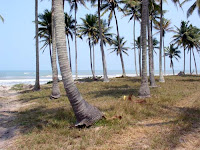I've been asked to guide a client here for 2 days, and since I've never been here, I came down two days early to find areas of accessible habitat. The area is mentioned in Steve Howell's birdfinding guide to Mexico, but birders have found that the habitats closest to town aren't as good any more.
Using Google Earth, I was able to discover some new birding areas nearby, and by talking to many ranchers gained access to land that had never been birded before.
My client's target birds included several found in wet cattail and grass marsh, such as Yellow-breasted Crake and King Rail. Unfortuantely almost everywhere the marsh was dry. Channels had been dug to drain much of the marsh to create areas where cattle could graze, and almost everywhere one could walk right up to impenetrable cattails without getting wet feet.
We did manage to get some good birds, such as Sedge Wren, Swamp Sparrow, and Upland Sandpiper, and with the many migrants and tropical residents I tallied a total of 206 species in four days. In the meantime, I managed to take a few photos of the habitat, critters, and flowers.
 Veined Tree Frog, Phrynohyas venulosa.
Veined Tree Frog, Phrynohyas venulosa. An unknown bush or small tree in the Mimosaceae family.
An unknown bush or small tree in the Mimosaceae family. A band-winged grasshopper that found safety in open sand through camouflage.
A band-winged grasshopper that found safety in open sand through camouflage. I drove through the Rancho La Isla de Santa Maria.
I drove through the Rancho La Isla de Santa Maria. The road eventually dumped me out on the beach 10 kilometers north of Tecolutla in the middle of a coconut plantation.
The road eventually dumped me out on the beach 10 kilometers north of Tecolutla in the middle of a coconut plantation. I then drove south on a road that paralelled the beach and found some nice shorebird spots.
I then drove south on a road that paralelled the beach and found some nice shorebird spots. Snowy Plover
Snowy Plover Near town is this raised dike that still had some wet marsh on both sides; this is where we finally caught up with Altamira Yellowthroat.
Near town is this raised dike that still had some wet marsh on both sides; this is where we finally caught up with Altamira Yellowthroat. Another private ranch called El Cacahuatal gave me permission to bird this fantastic marsh that was teeming with shorebirds, including American Golden-Plover, lots of yellowlegs, Pectoral, Stilt, and Least Sandpipers, White-faced Ibis, and many herons and egrets.
Another private ranch called El Cacahuatal gave me permission to bird this fantastic marsh that was teeming with shorebirds, including American Golden-Plover, lots of yellowlegs, Pectoral, Stilt, and Least Sandpipers, White-faced Ibis, and many herons and egrets. American Golden-Plover
American Golden-Plover A swamplily in the genus Crinum.
A swamplily in the genus Crinum. Snow-on-the-mountain, Euphorbia marginata
Snow-on-the-mountain, Euphorbia marginata Rose-bellied Lizard, Sceloporus variabilis. Rarely can you see the belly so well.
Rose-bellied Lizard, Sceloporus variabilis. Rarely can you see the belly so well. Ladder-backed Woodpecker
Ladder-backed Woodpecker Northern Jacana
Northern Jacana Keeled Earless-Lizard, Holbrookia propinqua
Keeled Earless-Lizard, Holbrookia propinqua Gentian species
Gentian species Cardinal Coral-bean, Erythrina herbacea
Cardinal Coral-bean, Erythrina herbacea Bullhorn Acacia, Acacia cornigera. This plant is well known for the Pseudomyrmex ants that live in the hollow spines and protect the plant from grazers and caterpillars. They also kill seedlings of plants around the base that might compete.
Bullhorn Acacia, Acacia cornigera. This plant is well known for the Pseudomyrmex ants that live in the hollow spines and protect the plant from grazers and caterpillars. They also kill seedlings of plants around the base that might compete.
 American Crocodile
American Crocodile





No comments:
Post a Comment